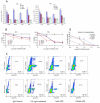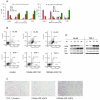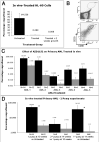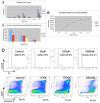AZD1152 rapidly and negatively affects the growth and survival of human acute myeloid leukemia cells in vitro and in vivo
- PMID: 19366807
- PMCID: PMC2684546
- DOI: 10.1158/0008-5472.CAN-08-3203
AZD1152 rapidly and negatively affects the growth and survival of human acute myeloid leukemia cells in vitro and in vivo
Abstract
Aurora kinases play a critical role in regulating mitosis and cell division, and their overexpression has been implicated in the survival and proliferation of human cancer. In this study, we report the in vitro and in vivo activities of AZD1152, a compound that has selectivity for aurora B kinase, in acute myeloid leukemia (AML) cell lines, primary AML samples, and cord blood cells. AZD1152 exerted antiproliferative or cytotoxic effects in all cell lines studied, inhibited the phosphorylation of histone H3 (pHis H3) on Ser10 in a dose-dependent manner, and resulted in cells with >4N DNA content. THP-1 cells treated with AZD1152 accumulated in a state of polyploidy and showed a senescent response to the drug, in contrast to the apoptotic response seen in other cell lines. Accordingly, AZD1152 profoundly affected the growth of AML cell lines and primary AML in an in vivo xenotransplantation model. However, concentration-dependent effects on cell growth, apoptosis, and cell cycle progression were also observed when human cord blood and primary lineage-negative stem and progenitor cells were analyzed in vitro and in vivo. These data suggest that the inhibition of aurora B kinase may be a useful therapeutic strategy in the treatment of AML and that further exploration of dosing and treatment schedules is warranted in clinical trials.
Figures





References
-
- Katayama H, Sasai K, Kawai H, et al. Phosphorylation by aurora kinase A induces Mdm2-mediated destabilization and inhibition of p53. Nat Genet. 2004;36:55–62. - PubMed
-
- Meraldi P, Honda R, Nigg EA. Aurora kinases link chromosome segregation and cell division to cancer susceptibility. Curr Opin Genet Dev. 2004;14:29–36. - PubMed
-
- Adams RR, Carmena M, Earnshaw WC. Chromosomal passengers and the (aurora) ABCs of mitosis. Trends Cell Biol. 2001;11:49–54. - PubMed
-
- Tang CJ, Lin CY, Tang TK. Dynamic localization and functional implications of Aurora-C kinase during male mouse meiosis. Dev Biol. 2006;290:398–410. - PubMed
Publication types
MeSH terms
Substances
Grants and funding
LinkOut - more resources
Full Text Sources
Other Literature Sources
Medical
Miscellaneous

